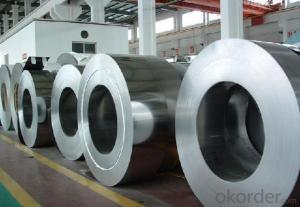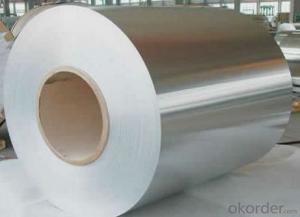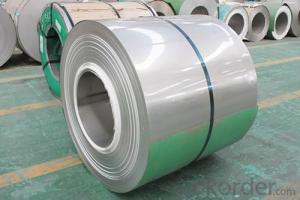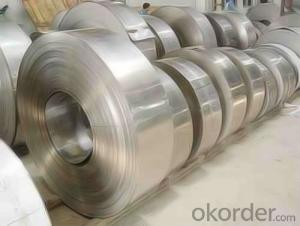HONGRI stainless steel coil with high quality 310s ba
- Loading Port:
- Guangzhou
- Payment Terms:
- TT OR LC
- Min Order Qty:
- 20 m.t.
- Supply Capability:
- 500 m.t./month
OKorder Service Pledge
OKorder Financial Service
You Might Also Like
Product name | 310s ba stainless steel coil with high quality |
Specification | Thickness: Cold rolled: 0.3-3mm, Hot Rolled: 3-120mm Width: 500-2000mm Length: 1000-6000mm Customized sizes are accepted |
Standard | ASME, ASTM, EN, BS, GB, DIN, JIS, etc |
Finish | NO.1, NO.4, 2B, BA, HL, 8K, Mirror finish and so on |
Material | 201, 202, 304, 304L, 310S, 316, 316L, 410, 420, 430, 441, 800H, 904L |
Brand Name | HONGRI |
Place of Origin | Jiangsu of China (Mainland) |
Technical treatment | Cold Rolled, Hot Rolled |
MOQ | 20 Metric Ton |
Port of Loading | GUANGZHOU |
Terms of Delivery | FOB, CFR, CIF, CNF, EXWORK |
Terms of Payment | L/C, T/T (30% desipot) |
Packing | Standard export sea-worthy packing |
Delivery time | Within 7days after recieve 30% desipot or as your requirement |
Stock | Ready in stocks |
310s ba stainless steel coil with high quality
Grade | C ≤ | Si ≤ | Mn ≤ | P ≤ | S ≤ | Ni ≤ | Cr ≤ |
201 | 0.12 | 0.75 | 7.00 | 0.045 | 0.045 | 1.00-1.28 | 13.70-15.70 |
202 | 0.15 | 1.00 | 2.25 | 0.045 | 0.045 | 4.07-4.17 | 14.00-16.00 |
304 | 0.08 | 0.75 | 2.00 | 0.045 | 0.03 | 8.00-11.00 | 18.00-20.00 |
304L | 0.035 | 0.75 | 2.00 | 0.045 | 0.03 | 8.00-13.00 | 18.00-20.00 |
309 | 0.15 | 0.75 | 2.00 | 0.045 | 0.03 | 12.00-15.00 | 22.00-24.00 |
310S | 0.08 | 1.50 | 2.00 | 0.045 | 0.03 | 19.00-22.00 | 24.00-26.00 |
316 | 0.08 | 1.00 | 2.00 | 0.045 | 0.03 | 10.00-14.00 | 16.00-18.00 |
316L | 0.035 | 0.75 | 2.00 | 0.045 | 0.03 | 10.00-15.00 | 16.00-18.00 |
321 | 0.04-0.10 | 0.75 | 2.00 | 0.045 | 0.03 | 9.00-13.00 | 17.00-20.00 |
405 | 0.08 | 0.75 | 1.00 | 0.045 | 0.03 | 0.06 | 11.5-13.5 |
409 | 0.089 | 1.00 | 1.00 | 0.045 | 0.05 | 0.06 | 10.50-11.75 |
410 | 0.15 | 0.75 | 1.00 | 0.045 | 0.03 | 0.06 | 11.5-13.5 |
420 | 0.16-0.25 | 1.00 | 1.00 | 0.040 | 0.03 | 0.06 | 12.00-14.00 |
430 | 0.12 | 0.75 | 1.00 | 0.045 | 0.03 | 0.06 | 16.00-18.00 |
904L | 0.02 | 1.0 | 2.00 | 0.045 | 0.03 | 23.00-28.00 | 19.00-23.00 |
Finishings
| Surface | Definition | Application |
| NO.1 | The surface finished by heat treatment and pickling or processes corresponding there to after hot rolling. | Chemical tank, pipe. |
| 2B | Those finished, after cold rolling, by heat treatment, pickling or other equivalent treatment and lastly by cold rolling to given appropriate luster. | Medical equipment, Food industry, Construction material, Kitchen utensils. |
NO.3 | Those finished by polishing with No.100 to No.120 abrasives specified in JIS R6001. | Kitchen utensils, Building construction |
NO.4 | Those finished by polishing with No.150 to No.180 abrasives specified in JIS R6001. | Kitchen utensils, Building construction, Medical equipment. |
HL | Those finished polishing so as to give continuous polishing streaks by using abrasive of suitable grain size | Building Construction. |
BA (No.6) | Those processed with bright heat treatment after cold rolling.
| Kitchen utensils, Electric equipment, Building construction. |
Mirror (No.8) | Shinning like a mirror | Building construction |
- Q:Are stainless steel strips prone to rusting?
- Rusting is not a common issue with stainless steel strips. Stainless steel, an alloy primarily made up of iron, chromium, and other elements, possesses properties that make it resistant to corrosion. The presence of chromium creates a protective layer on the steel's surface known as chromium oxide. This layer acts as a barrier, shielding the steel from oxygen and moisture and preventing the formation of rust. However, certain circumstances, such as exposure to chlorides, acids, or high humidity environments, can still lead to corrosion or staining of stainless steel. Therefore, even though stainless steel strips are highly resistant to rust, it is still necessary to take proper care and maintain them to ensure their durability.
- Q:What are the different types of slitting for stainless steel strips?
- There are several different types of slitting techniques for stainless steel strips, including rotary slitting, loop slitting, and pull-through slitting. Each method has its own advantages and is suited for different applications. Rotary slitting involves using a rotating circular blade to cut the stainless steel strip into narrower strips. Loop slitting involves feeding the strip through a loop and utilizing two rotating circular blades to cut the strip. Pull-through slitting, on the other hand, uses a set of tensioned rolls to pull the strip through a set of knives, resulting in precise and accurate cuts. The choice of slitting technique depends on factors such as strip thickness, width requirements, and desired edge quality.
- Q:Can stainless steel strips be customized according to specific requirements?
- Certainly! Stainless steel strips have the capability to be personalized in accordance with specific needs. Stainless steel, being a flexible material, can be easily molded, trimmed, and modified into diverse forms and dimensions. This permits customization to fulfill particular requirements, including width, thickness, length, and surface quality. Furthermore, stainless steel strips can undergo additional customization through techniques such as slitting, edge treatment, and surface refinement to enhance their functionality and aesthetics. Regardless of whether it is for industrial, architectural, or decorative purposes, stainless steel strips can be meticulously tailored to precisely match the specifications and demands of a specific application.
- Q:Can stainless steel strips be used in the pharmaceutical industry?
- Yes, stainless steel strips can be used in the pharmaceutical industry. Stainless steel is a popular material choice due to its high corrosion resistance, durability, and ability to withstand high temperatures and harsh chemicals. It is commonly used for manufacturing pharmaceutical equipment, storage tanks, and process piping to maintain hygienic conditions and prevent contamination in pharmaceutical processes.
- Q:What is the typical lead time for stainless steel strip production?
- The typical lead time for stainless steel strip production can vary depending on various factors such as the complexity of the order, the quantity required, and the current market conditions. Generally, lead times can range from a few weeks to several months. For standard stainless steel strip production, where the specifications and quantity required are within normal limits, the lead time is typically shorter. In such cases, it may take around 4-8 weeks for the production process, including material sourcing, processing, and quality control, to be completed. However, for customized or specialty stainless steel strip production, which involves specific dimensions, finishes, or unique requirements, the lead time can be longer. It may require additional time for design consultations, tooling development, and testing, resulting in lead times of 2-6 months or even more. External factors such as supply and demand dynamics, availability of raw materials, and production capacities can also influence lead times. During periods of high demand or when there are supply chain disruptions, lead times may increase due to increased order volumes and potential delays in material sourcing. It is important to communicate with the stainless steel strip manufacturer or supplier to get an accurate estimate of the lead time based on your specific requirements. They will consider various factors and provide you with a more precise timeline for production and delivery.
- Q:Can stainless steel strips be used in cryogenic applications?
- Yes, stainless steel strips can be used in cryogenic applications. Stainless steel is known for its excellent resistance to extreme temperatures, including low temperatures found in cryogenic environments. It retains its strength and integrity even at very low temperatures, making it suitable for use in cryogenic applications. Additionally, stainless steel has good corrosion resistance, which is essential in cryogenic environments where moisture and other corrosive elements may be present. Overall, stainless steel strips are a reliable and durable choice for use in cryogenic applications.
- Q:Can stainless steel strips be used in brewery equipment?
- Yes, stainless steel strips can be used in brewery equipment. Stainless steel is a popular choice for brewery equipment due to its excellent corrosion resistance, strength, and hygiene properties. Stainless steel strips can be used in various components of brewery equipment, such as fermenters, mash tuns, brewing kettles, and piping systems. The high resistance to corrosion and oxidation makes stainless steel strips ideal for withstanding the harsh acidic and alkaline conditions present in brewing processes. Additionally, stainless steel is easy to clean and maintain, ensuring the quality and purity of the beer being produced. Its durability and strength also provide longevity to the equipment, making stainless steel strips a reliable choice for brewery applications.
- Q:Are stainless steel strips suitable for outdoor applications?
- Yes, stainless steel strips are suitable for outdoor applications. Stainless steel is highly resistant to corrosion, making it ideal for use in outdoor environments where it may be exposed to moisture, sunlight, and other weather conditions. Additionally, stainless steel has a high strength-to-weight ratio and excellent durability, ensuring long-lasting performance even in harsh outdoor settings.
- Q:Can 111 stainless steel strips be formed into wire for various applications?
- Absolutely! It is entirely possible to convert 111 stainless steel strips into wire, which can serve multiple purposes. Stainless steel is renowned for its remarkable ability to be molded and stretched, hence making it highly suitable for wire manufacturing. By undergoing a sequence of manufacturing methods like drawing, annealing, and cold rolling, these strips can be seamlessly transformed into wire. Consequently, the resultant stainless steel wire can be effectively utilized in an extensive array of applications encompassing electrical wiring, springs, fasteners, welding electrodes, and mesh.
- Q:Can stainless steel strips be used in kitchenware?
- Kitchenware can indeed utilize stainless steel strips. The durability, corrosion resistance, and ease of cleaning make stainless steel a favored option for kitchenware. Knives, utensils, pots, pans, and appliances are among the many kitchenware items in which stainless steel strips find use. The superior quality and non-reactive properties of stainless steel make it perfect for preparing and cooking food. Furthermore, stainless steel promotes hygiene by preventing the growth of bacteria or germs. All in all, stainless steel strips are a dependable and enduring selection for kitchenware.
1. Manufacturer Overview |
|
|---|---|
| Location | |
| Year Established | |
| Annual Output Value | |
| Main Markets | |
| Company Certifications | |
2. Manufacturer Certificates |
|
|---|---|
| a) Certification Name | |
| Range | |
| Reference | |
| Validity Period | |
3. Manufacturer Capability |
|
|---|---|
| a)Trade Capacity | |
| Nearest Port | |
| Export Percentage | |
| No.of Employees in Trade Department | |
| Language Spoken: | |
| b)Factory Information | |
| Factory Size: | |
| No. of Production Lines | |
| Contract Manufacturing | |
| Product Price Range | |
Send your message to us
HONGRI stainless steel coil with high quality 310s ba
- Loading Port:
- Guangzhou
- Payment Terms:
- TT OR LC
- Min Order Qty:
- 20 m.t.
- Supply Capability:
- 500 m.t./month
OKorder Service Pledge
OKorder Financial Service
Similar products
New products
Hot products
Related keywords































